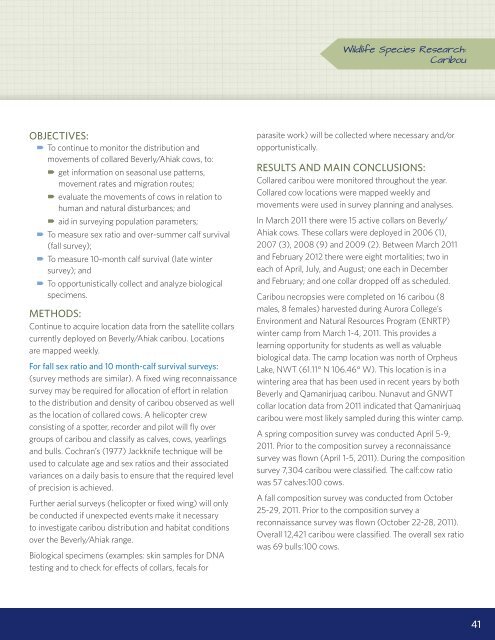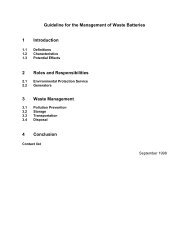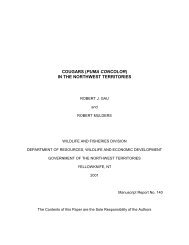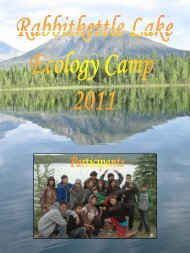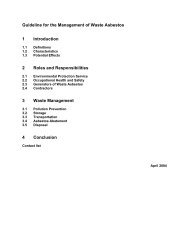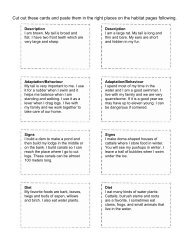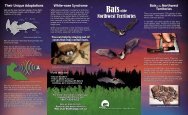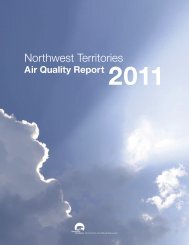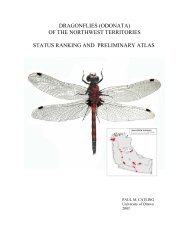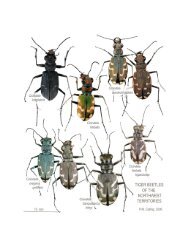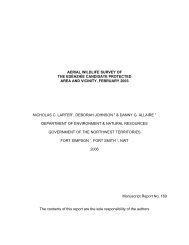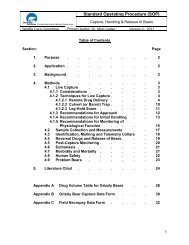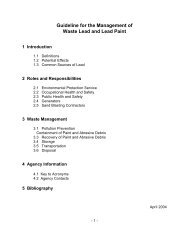2011 Annual Report of NWT Wildlife Research Permits and Western ...
2011 Annual Report of NWT Wildlife Research Permits and Western ...
2011 Annual Report of NWT Wildlife Research Permits and Western ...
You also want an ePaper? Increase the reach of your titles
YUMPU automatically turns print PDFs into web optimized ePapers that Google loves.
<strong>Wildlife</strong> Species <strong>Research</strong>:<br />
Caribou<br />
OBJECTIVES:<br />
´ ´ To continue to monitor the distribution <strong>and</strong><br />
movements <strong>of</strong> collared Beverly/Ahiak cows, to:<br />
´ ´ get information on seasonal use patterns,<br />
movement rates <strong>and</strong> migration routes;<br />
´ ´ evaluate the movements <strong>of</strong> cows in relation to<br />
human <strong>and</strong> natural disturbances; <strong>and</strong><br />
´ ´ aid in surveying population parameters;<br />
´ ´ To measure sex ratio <strong>and</strong> over-summer calf survival<br />
(fall survey);<br />
´ ´ To measure 10-month calf survival (late winter<br />
survey); <strong>and</strong><br />
´ ´ To opportunistically collect <strong>and</strong> analyze biological<br />
specimens.<br />
METHODS:<br />
Continue to acquire location data from the satellite collars<br />
currently deployed on Beverly/Ahiak caribou. Locations<br />
are mapped weekly.<br />
For fall sex ratio <strong>and</strong> 10 month-calf survival surveys:<br />
(survey methods are similar). A fixed wing reconnaissance<br />
survey may be required for allocation <strong>of</strong> effort in relation<br />
to the distribution <strong>and</strong> density <strong>of</strong> caribou observed as well<br />
as the location <strong>of</strong> collared cows. A helicopter crew<br />
consisting <strong>of</strong> a spotter, recorder <strong>and</strong> pilot will fly over<br />
groups <strong>of</strong> caribou <strong>and</strong> classify as calves, cows, yearlings<br />
<strong>and</strong> bulls. Cochran’s (1977) Jackknife technique will be<br />
used to calculate age <strong>and</strong> sex ratios <strong>and</strong> their associated<br />
variances on a daily basis to ensure that the required level<br />
<strong>of</strong> precision is achieved.<br />
Further aerial surveys (helicopter or fixed wing) will only<br />
be conducted if unexpected events make it necessary<br />
to investigate caribou distribution <strong>and</strong> habitat conditions<br />
over the Beverly/Ahiak range.<br />
Biological specimens (examples: skin samples for DNA<br />
testing <strong>and</strong> to check for effects <strong>of</strong> collars, fecals for<br />
parasite work) will be collected where necessary <strong>and</strong>/or<br />
opportunistically.<br />
RESULTS AND MAIN CONCLUSIONS:<br />
Collared caribou were monitored throughout the year.<br />
Collared cow locations were mapped weekly <strong>and</strong><br />
movements were used in survey planning <strong>and</strong> analyses.<br />
In March <strong>2011</strong> there were 15 active collars on Beverly/<br />
Ahiak cows. These collars were deployed in 2006 (1),<br />
2007 (3), 2008 (9) <strong>and</strong> 2009 (2). Between March <strong>2011</strong><br />
<strong>and</strong> February 2012 there were eight mortalities; two in<br />
each <strong>of</strong> April, July, <strong>and</strong> August; one each in December<br />
<strong>and</strong> February; <strong>and</strong> one collar dropped <strong>of</strong>f as scheduled.<br />
Caribou necropsies were completed on 16 caribou (8<br />
males, 8 females) harvested during Aurora College’s<br />
Environment <strong>and</strong> Natural Resources Program (ENRTP)<br />
winter camp from March 1-4, <strong>2011</strong>. This provides a<br />
learning opportunity for students as well as valuable<br />
biological data. The camp location was north <strong>of</strong> Orpheus<br />
Lake, <strong>NWT</strong> (61.11° N 106.46° W). This location is in a<br />
wintering area that has been used in recent years by both<br />
Beverly <strong>and</strong> Qamanirjuaq caribou. Nunavut <strong>and</strong> G<strong>NWT</strong><br />
collar location data from <strong>2011</strong> indicated that Qamanirjuaq<br />
caribou were most likely sampled during this winter camp.<br />
A spring composition survey was conducted April 5-9,<br />
<strong>2011</strong>. Prior to the composition survey a reconnaissance<br />
survey was flown (April 1-5, <strong>2011</strong>). During the composition<br />
survey 7,304 caribou were classified. The calf:cow ratio<br />
was 57 calves:100 cows.<br />
A fall composition survey was conducted from October<br />
25-29, <strong>2011</strong>. Prior to the composition survey a<br />
reconnaissance survey was flown (October 22-28, <strong>2011</strong>).<br />
Overall 12,421 caribou were classified. The overall sex ratio<br />
was 69 bulls:100 cows.<br />
41


